NUR302: Leadership in a Nursing Team - Clinical Scenario Report
VerifiedAdded on 2022/08/31
|9
|3179
|17
Report
AI Summary
This report analyzes the leadership roles of registered nurses (RNs) within a nursing team, focusing on the application of delegation and supervision processes in two clinical scenarios. The report references the Australian College of Nursing (ACN) and the National Safety and Quality Health Service Standards (NSQHS) to define the leadership responsibilities of RNs, including adherence to standards of clinical leadership and risk management. The analysis includes a decision-making framework based on the Nursing and Midwifery Board of Australia (NMBA) guidelines, emphasizing the importance of competency, scope of practice, and patient outcomes when delegating tasks. The report examines the NMBA standards, specifically focusing on evidence-based practice, patient assessment, and communication within the healthcare team. The scenarios involve graduate RNs, senior RNs, enrolled nurses (ENs), and assistants in nursing (AINs), highlighting the importance of interprofessional collaboration and patient-centered care. The report also addresses the significance of patient education, communication, and adherence to professional standards to ensure safe and quality patient care.
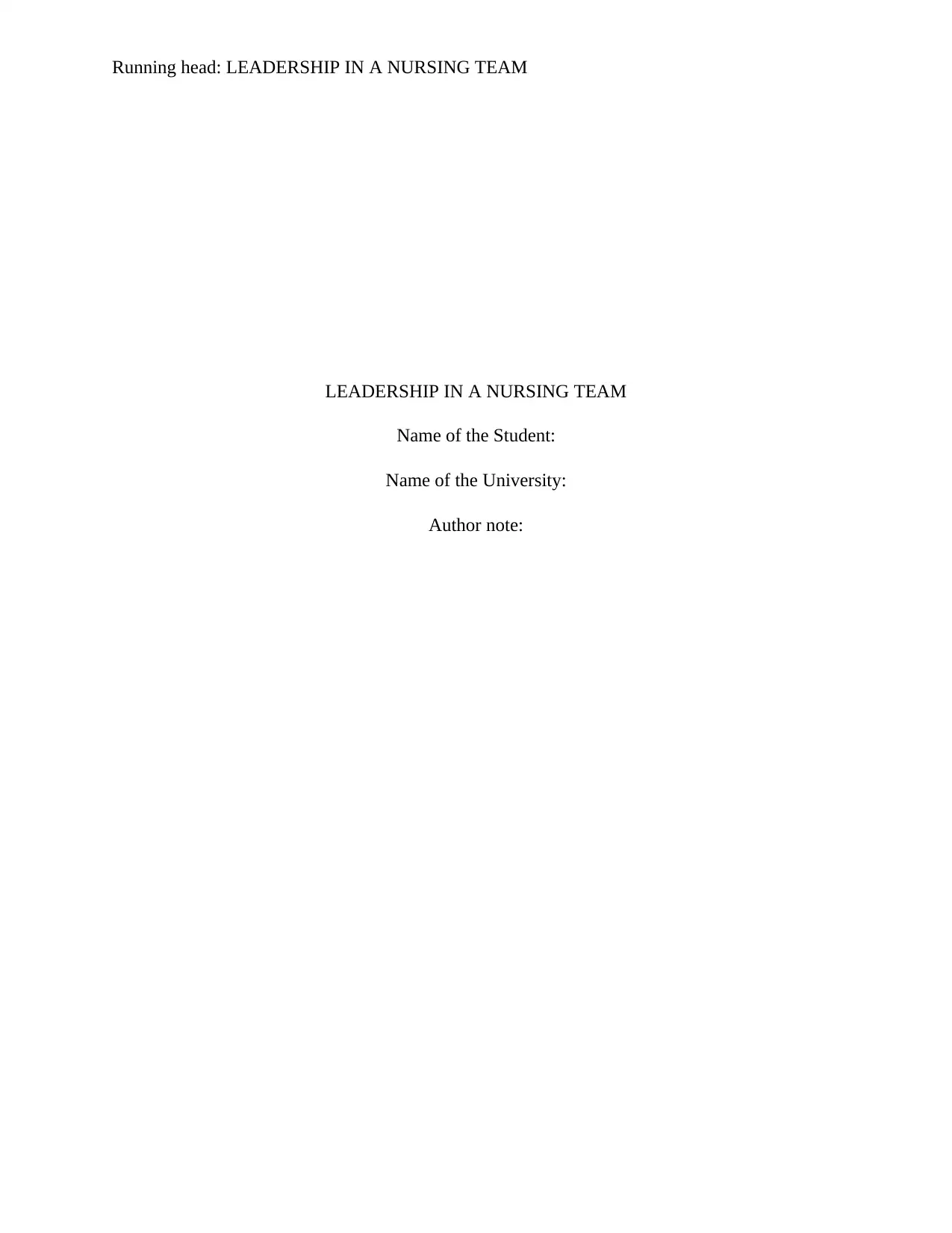
Running head: LEADERSHIP IN A NURSING TEAM
LEADERSHIP IN A NURSING TEAM
Name of the Student:
Name of the University:
Author note:
LEADERSHIP IN A NURSING TEAM
Name of the Student:
Name of the University:
Author note:
Paraphrase This Document
Need a fresh take? Get an instant paraphrase of this document with our AI Paraphraser
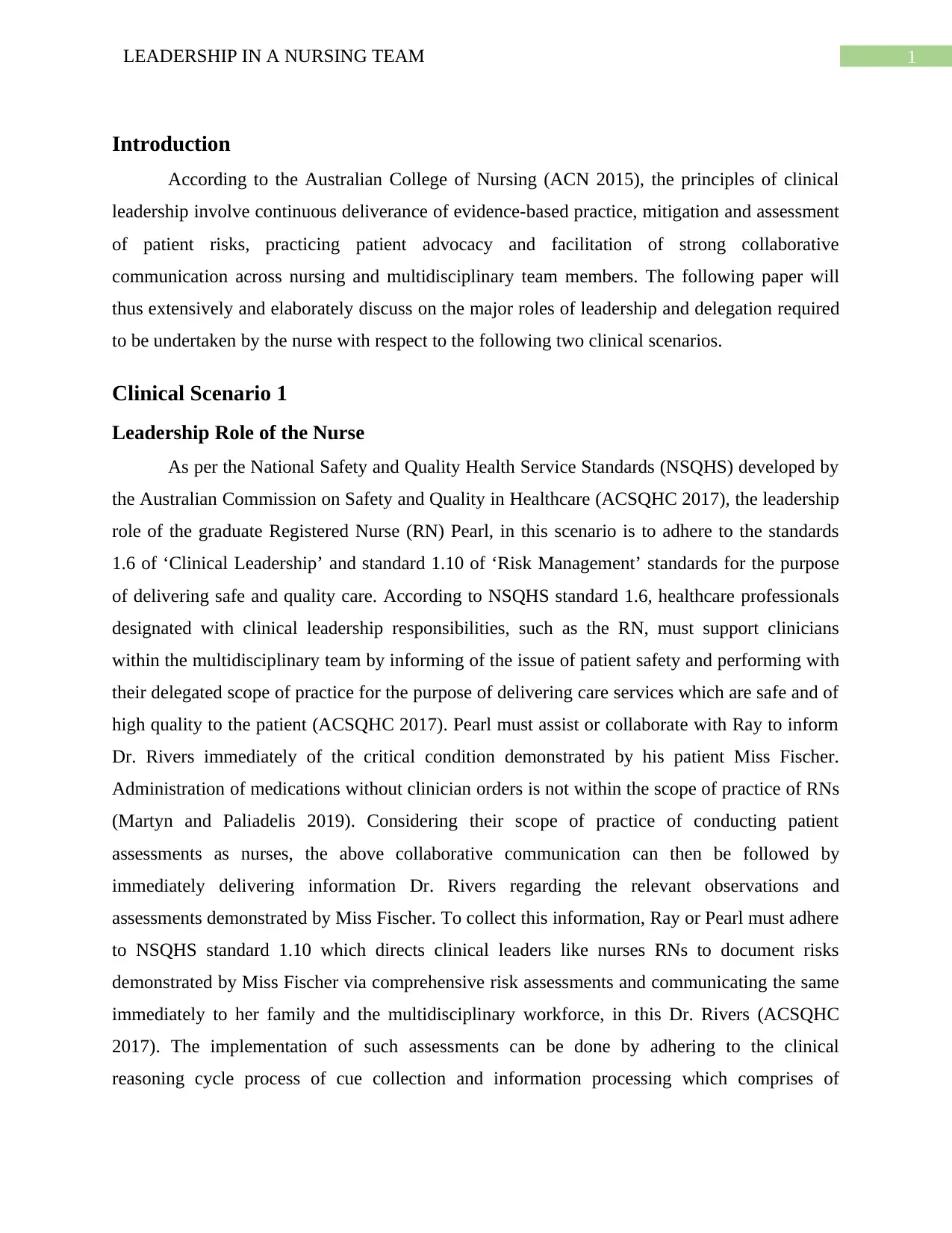
1LEADERSHIP IN A NURSING TEAM
Introduction
According to the Australian College of Nursing (ACN 2015), the principles of clinical
leadership involve continuous deliverance of evidence-based practice, mitigation and assessment
of patient risks, practicing patient advocacy and facilitation of strong collaborative
communication across nursing and multidisciplinary team members. The following paper will
thus extensively and elaborately discuss on the major roles of leadership and delegation required
to be undertaken by the nurse with respect to the following two clinical scenarios.
Clinical Scenario 1
Leadership Role of the Nurse
As per the National Safety and Quality Health Service Standards (NSQHS) developed by
the Australian Commission on Safety and Quality in Healthcare (ACSQHC 2017), the leadership
role of the graduate Registered Nurse (RN) Pearl, in this scenario is to adhere to the standards
1.6 of ‘Clinical Leadership’ and standard 1.10 of ‘Risk Management’ standards for the purpose
of delivering safe and quality care. According to NSQHS standard 1.6, healthcare professionals
designated with clinical leadership responsibilities, such as the RN, must support clinicians
within the multidisciplinary team by informing of the issue of patient safety and performing with
their delegated scope of practice for the purpose of delivering care services which are safe and of
high quality to the patient (ACSQHC 2017). Pearl must assist or collaborate with Ray to inform
Dr. Rivers immediately of the critical condition demonstrated by his patient Miss Fischer.
Administration of medications without clinician orders is not within the scope of practice of RNs
(Martyn and Paliadelis 2019). Considering their scope of practice of conducting patient
assessments as nurses, the above collaborative communication can then be followed by
immediately delivering information Dr. Rivers regarding the relevant observations and
assessments demonstrated by Miss Fischer. To collect this information, Ray or Pearl must adhere
to NSQHS standard 1.10 which directs clinical leaders like nurses RNs to document risks
demonstrated by Miss Fischer via comprehensive risk assessments and communicating the same
immediately to her family and the multidisciplinary workforce, in this Dr. Rivers (ACSQHC
2017). The implementation of such assessments can be done by adhering to the clinical
reasoning cycle process of cue collection and information processing which comprises of
Introduction
According to the Australian College of Nursing (ACN 2015), the principles of clinical
leadership involve continuous deliverance of evidence-based practice, mitigation and assessment
of patient risks, practicing patient advocacy and facilitation of strong collaborative
communication across nursing and multidisciplinary team members. The following paper will
thus extensively and elaborately discuss on the major roles of leadership and delegation required
to be undertaken by the nurse with respect to the following two clinical scenarios.
Clinical Scenario 1
Leadership Role of the Nurse
As per the National Safety and Quality Health Service Standards (NSQHS) developed by
the Australian Commission on Safety and Quality in Healthcare (ACSQHC 2017), the leadership
role of the graduate Registered Nurse (RN) Pearl, in this scenario is to adhere to the standards
1.6 of ‘Clinical Leadership’ and standard 1.10 of ‘Risk Management’ standards for the purpose
of delivering safe and quality care. According to NSQHS standard 1.6, healthcare professionals
designated with clinical leadership responsibilities, such as the RN, must support clinicians
within the multidisciplinary team by informing of the issue of patient safety and performing with
their delegated scope of practice for the purpose of delivering care services which are safe and of
high quality to the patient (ACSQHC 2017). Pearl must assist or collaborate with Ray to inform
Dr. Rivers immediately of the critical condition demonstrated by his patient Miss Fischer.
Administration of medications without clinician orders is not within the scope of practice of RNs
(Martyn and Paliadelis 2019). Considering their scope of practice of conducting patient
assessments as nurses, the above collaborative communication can then be followed by
immediately delivering information Dr. Rivers regarding the relevant observations and
assessments demonstrated by Miss Fischer. To collect this information, Ray or Pearl must adhere
to NSQHS standard 1.10 which directs clinical leaders like nurses RNs to document risks
demonstrated by Miss Fischer via comprehensive risk assessments and communicating the same
immediately to her family and the multidisciplinary workforce, in this Dr. Rivers (ACSQHC
2017). The implementation of such assessments can be done by adhering to the clinical
reasoning cycle process of cue collection and information processing which comprises of
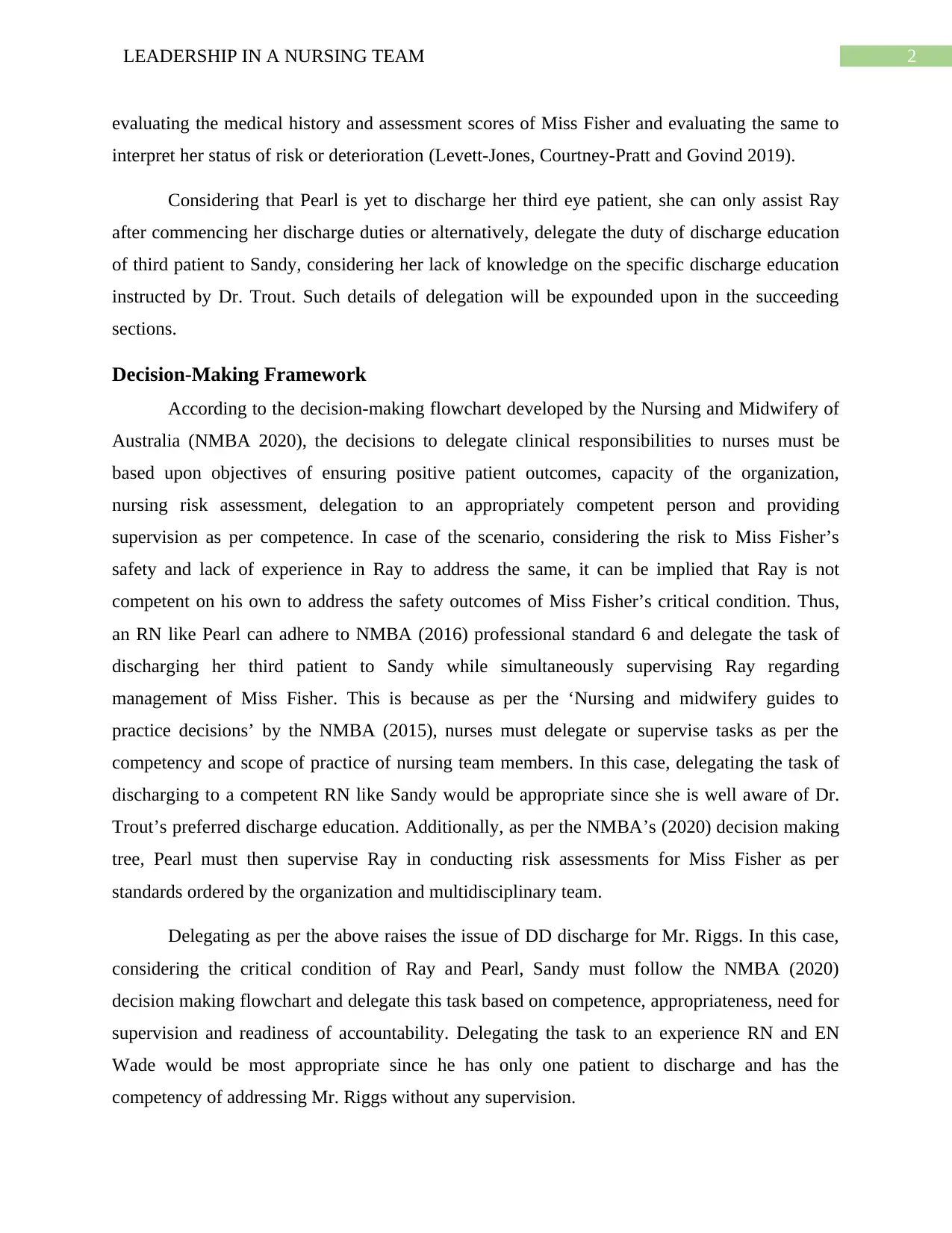
2LEADERSHIP IN A NURSING TEAM
evaluating the medical history and assessment scores of Miss Fisher and evaluating the same to
interpret her status of risk or deterioration (Levett-Jones, Courtney-Pratt and Govind 2019).
Considering that Pearl is yet to discharge her third eye patient, she can only assist Ray
after commencing her discharge duties or alternatively, delegate the duty of discharge education
of third patient to Sandy, considering her lack of knowledge on the specific discharge education
instructed by Dr. Trout. Such details of delegation will be expounded upon in the succeeding
sections.
Decision-Making Framework
According to the decision-making flowchart developed by the Nursing and Midwifery of
Australia (NMBA 2020), the decisions to delegate clinical responsibilities to nurses must be
based upon objectives of ensuring positive patient outcomes, capacity of the organization,
nursing risk assessment, delegation to an appropriately competent person and providing
supervision as per competence. In case of the scenario, considering the risk to Miss Fisher’s
safety and lack of experience in Ray to address the same, it can be implied that Ray is not
competent on his own to address the safety outcomes of Miss Fisher’s critical condition. Thus,
an RN like Pearl can adhere to NMBA (2016) professional standard 6 and delegate the task of
discharging her third patient to Sandy while simultaneously supervising Ray regarding
management of Miss Fisher. This is because as per the ‘Nursing and midwifery guides to
practice decisions’ by the NMBA (2015), nurses must delegate or supervise tasks as per the
competency and scope of practice of nursing team members. In this case, delegating the task of
discharging to a competent RN like Sandy would be appropriate since she is well aware of Dr.
Trout’s preferred discharge education. Additionally, as per the NMBA’s (2020) decision making
tree, Pearl must then supervise Ray in conducting risk assessments for Miss Fisher as per
standards ordered by the organization and multidisciplinary team.
Delegating as per the above raises the issue of DD discharge for Mr. Riggs. In this case,
considering the critical condition of Ray and Pearl, Sandy must follow the NMBA (2020)
decision making flowchart and delegate this task based on competence, appropriateness, need for
supervision and readiness of accountability. Delegating the task to an experience RN and EN
Wade would be most appropriate since he has only one patient to discharge and has the
competency of addressing Mr. Riggs without any supervision.
evaluating the medical history and assessment scores of Miss Fisher and evaluating the same to
interpret her status of risk or deterioration (Levett-Jones, Courtney-Pratt and Govind 2019).
Considering that Pearl is yet to discharge her third eye patient, she can only assist Ray
after commencing her discharge duties or alternatively, delegate the duty of discharge education
of third patient to Sandy, considering her lack of knowledge on the specific discharge education
instructed by Dr. Trout. Such details of delegation will be expounded upon in the succeeding
sections.
Decision-Making Framework
According to the decision-making flowchart developed by the Nursing and Midwifery of
Australia (NMBA 2020), the decisions to delegate clinical responsibilities to nurses must be
based upon objectives of ensuring positive patient outcomes, capacity of the organization,
nursing risk assessment, delegation to an appropriately competent person and providing
supervision as per competence. In case of the scenario, considering the risk to Miss Fisher’s
safety and lack of experience in Ray to address the same, it can be implied that Ray is not
competent on his own to address the safety outcomes of Miss Fisher’s critical condition. Thus,
an RN like Pearl can adhere to NMBA (2016) professional standard 6 and delegate the task of
discharging her third patient to Sandy while simultaneously supervising Ray regarding
management of Miss Fisher. This is because as per the ‘Nursing and midwifery guides to
practice decisions’ by the NMBA (2015), nurses must delegate or supervise tasks as per the
competency and scope of practice of nursing team members. In this case, delegating the task of
discharging to a competent RN like Sandy would be appropriate since she is well aware of Dr.
Trout’s preferred discharge education. Additionally, as per the NMBA’s (2020) decision making
tree, Pearl must then supervise Ray in conducting risk assessments for Miss Fisher as per
standards ordered by the organization and multidisciplinary team.
Delegating as per the above raises the issue of DD discharge for Mr. Riggs. In this case,
considering the critical condition of Ray and Pearl, Sandy must follow the NMBA (2020)
decision making flowchart and delegate this task based on competence, appropriateness, need for
supervision and readiness of accountability. Delegating the task to an experience RN and EN
Wade would be most appropriate since he has only one patient to discharge and has the
competency of addressing Mr. Riggs without any supervision.
⊘ This is a preview!⊘
Do you want full access?
Subscribe today to unlock all pages.

Trusted by 1+ million students worldwide
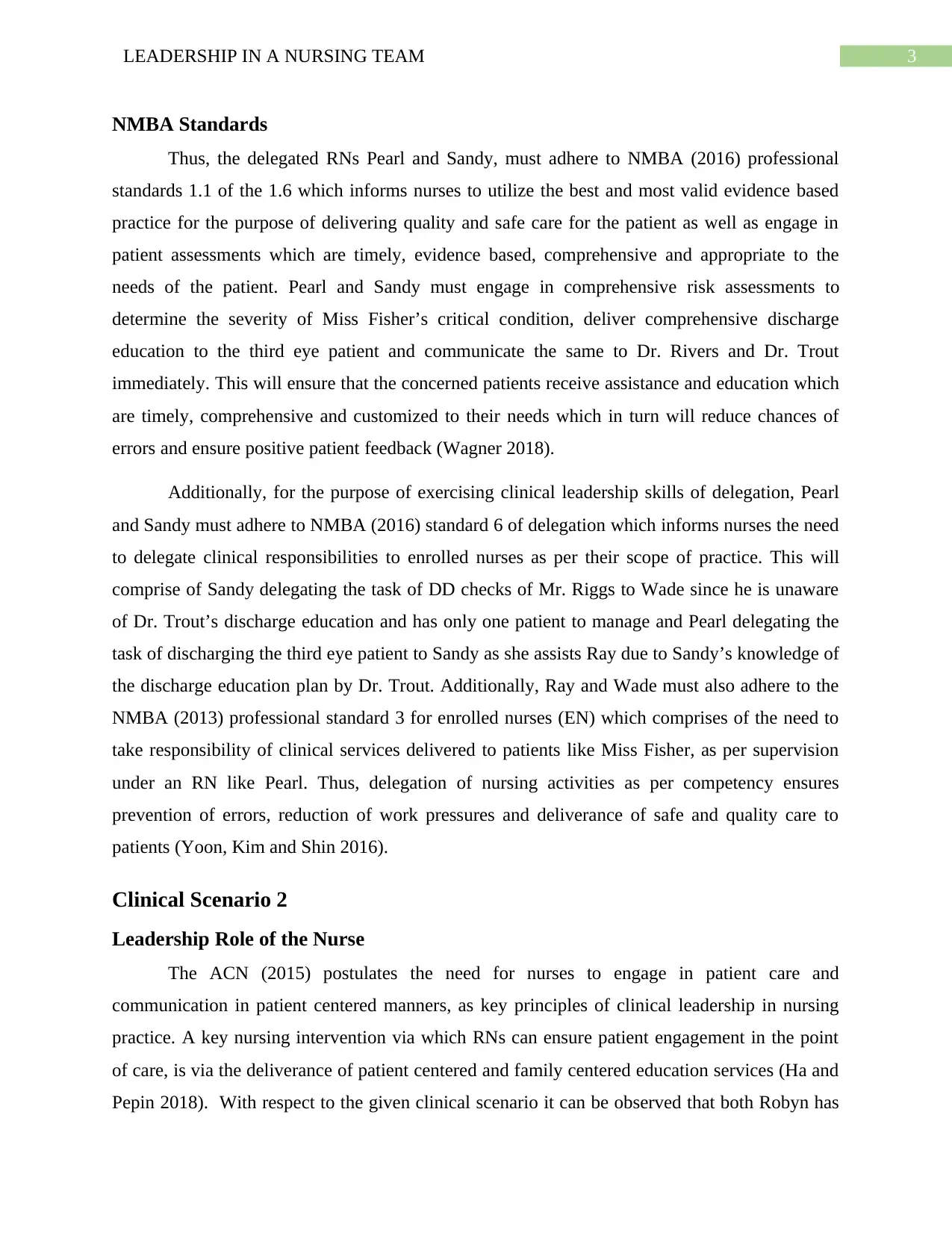
3LEADERSHIP IN A NURSING TEAM
NMBA Standards
Thus, the delegated RNs Pearl and Sandy, must adhere to NMBA (2016) professional
standards 1.1 of the 1.6 which informs nurses to utilize the best and most valid evidence based
practice for the purpose of delivering quality and safe care for the patient as well as engage in
patient assessments which are timely, evidence based, comprehensive and appropriate to the
needs of the patient. Pearl and Sandy must engage in comprehensive risk assessments to
determine the severity of Miss Fisher’s critical condition, deliver comprehensive discharge
education to the third eye patient and communicate the same to Dr. Rivers and Dr. Trout
immediately. This will ensure that the concerned patients receive assistance and education which
are timely, comprehensive and customized to their needs which in turn will reduce chances of
errors and ensure positive patient feedback (Wagner 2018).
Additionally, for the purpose of exercising clinical leadership skills of delegation, Pearl
and Sandy must adhere to NMBA (2016) standard 6 of delegation which informs nurses the need
to delegate clinical responsibilities to enrolled nurses as per their scope of practice. This will
comprise of Sandy delegating the task of DD checks of Mr. Riggs to Wade since he is unaware
of Dr. Trout’s discharge education and has only one patient to manage and Pearl delegating the
task of discharging the third eye patient to Sandy as she assists Ray due to Sandy’s knowledge of
the discharge education plan by Dr. Trout. Additionally, Ray and Wade must also adhere to the
NMBA (2013) professional standard 3 for enrolled nurses (EN) which comprises of the need to
take responsibility of clinical services delivered to patients like Miss Fisher, as per supervision
under an RN like Pearl. Thus, delegation of nursing activities as per competency ensures
prevention of errors, reduction of work pressures and deliverance of safe and quality care to
patients (Yoon, Kim and Shin 2016).
Clinical Scenario 2
Leadership Role of the Nurse
The ACN (2015) postulates the need for nurses to engage in patient care and
communication in patient centered manners, as key principles of clinical leadership in nursing
practice. A key nursing intervention via which RNs can ensure patient engagement in the point
of care, is via the deliverance of patient centered and family centered education services (Ha and
Pepin 2018). With respect to the given clinical scenario it can be observed that both Robyn has
NMBA Standards
Thus, the delegated RNs Pearl and Sandy, must adhere to NMBA (2016) professional
standards 1.1 of the 1.6 which informs nurses to utilize the best and most valid evidence based
practice for the purpose of delivering quality and safe care for the patient as well as engage in
patient assessments which are timely, evidence based, comprehensive and appropriate to the
needs of the patient. Pearl and Sandy must engage in comprehensive risk assessments to
determine the severity of Miss Fisher’s critical condition, deliver comprehensive discharge
education to the third eye patient and communicate the same to Dr. Rivers and Dr. Trout
immediately. This will ensure that the concerned patients receive assistance and education which
are timely, comprehensive and customized to their needs which in turn will reduce chances of
errors and ensure positive patient feedback (Wagner 2018).
Additionally, for the purpose of exercising clinical leadership skills of delegation, Pearl
and Sandy must adhere to NMBA (2016) standard 6 of delegation which informs nurses the need
to delegate clinical responsibilities to enrolled nurses as per their scope of practice. This will
comprise of Sandy delegating the task of DD checks of Mr. Riggs to Wade since he is unaware
of Dr. Trout’s discharge education and has only one patient to manage and Pearl delegating the
task of discharging the third eye patient to Sandy as she assists Ray due to Sandy’s knowledge of
the discharge education plan by Dr. Trout. Additionally, Ray and Wade must also adhere to the
NMBA (2013) professional standard 3 for enrolled nurses (EN) which comprises of the need to
take responsibility of clinical services delivered to patients like Miss Fisher, as per supervision
under an RN like Pearl. Thus, delegation of nursing activities as per competency ensures
prevention of errors, reduction of work pressures and deliverance of safe and quality care to
patients (Yoon, Kim and Shin 2016).
Clinical Scenario 2
Leadership Role of the Nurse
The ACN (2015) postulates the need for nurses to engage in patient care and
communication in patient centered manners, as key principles of clinical leadership in nursing
practice. A key nursing intervention via which RNs can ensure patient engagement in the point
of care, is via the deliverance of patient centered and family centered education services (Ha and
Pepin 2018). With respect to the given clinical scenario it can be observed that both Robyn has
Paraphrase This Document
Need a fresh take? Get an instant paraphrase of this document with our AI Paraphraser
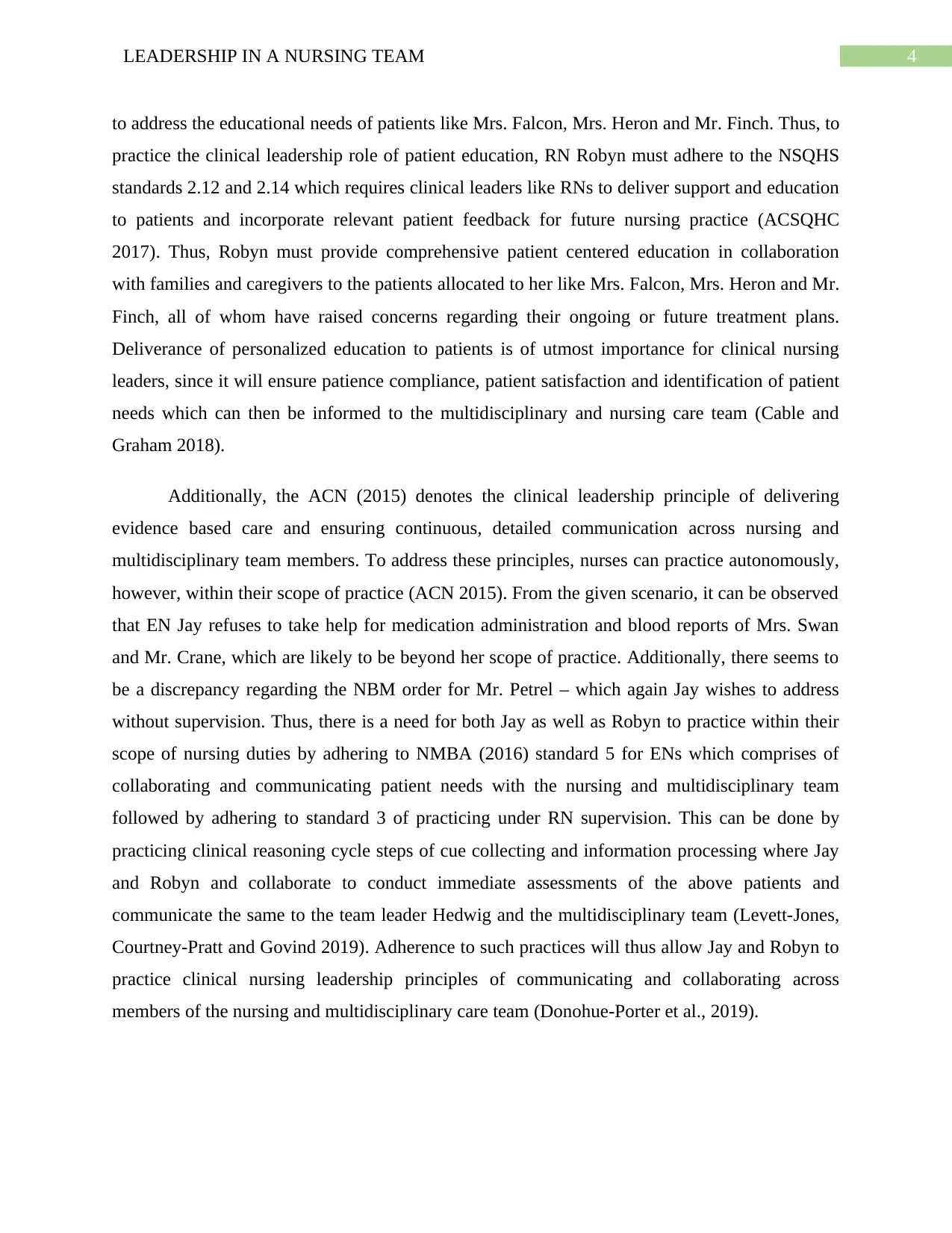
4LEADERSHIP IN A NURSING TEAM
to address the educational needs of patients like Mrs. Falcon, Mrs. Heron and Mr. Finch. Thus, to
practice the clinical leadership role of patient education, RN Robyn must adhere to the NSQHS
standards 2.12 and 2.14 which requires clinical leaders like RNs to deliver support and education
to patients and incorporate relevant patient feedback for future nursing practice (ACSQHC
2017). Thus, Robyn must provide comprehensive patient centered education in collaboration
with families and caregivers to the patients allocated to her like Mrs. Falcon, Mrs. Heron and Mr.
Finch, all of whom have raised concerns regarding their ongoing or future treatment plans.
Deliverance of personalized education to patients is of utmost importance for clinical nursing
leaders, since it will ensure patience compliance, patient satisfaction and identification of patient
needs which can then be informed to the multidisciplinary and nursing care team (Cable and
Graham 2018).
Additionally, the ACN (2015) denotes the clinical leadership principle of delivering
evidence based care and ensuring continuous, detailed communication across nursing and
multidisciplinary team members. To address these principles, nurses can practice autonomously,
however, within their scope of practice (ACN 2015). From the given scenario, it can be observed
that EN Jay refuses to take help for medication administration and blood reports of Mrs. Swan
and Mr. Crane, which are likely to be beyond her scope of practice. Additionally, there seems to
be a discrepancy regarding the NBM order for Mr. Petrel – which again Jay wishes to address
without supervision. Thus, there is a need for both Jay as well as Robyn to practice within their
scope of nursing duties by adhering to NMBA (2016) standard 5 for ENs which comprises of
collaborating and communicating patient needs with the nursing and multidisciplinary team
followed by adhering to standard 3 of practicing under RN supervision. This can be done by
practicing clinical reasoning cycle steps of cue collecting and information processing where Jay
and Robyn and collaborate to conduct immediate assessments of the above patients and
communicate the same to the team leader Hedwig and the multidisciplinary team (Levett-Jones,
Courtney-Pratt and Govind 2019). Adherence to such practices will thus allow Jay and Robyn to
practice clinical nursing leadership principles of communicating and collaborating across
members of the nursing and multidisciplinary care team (Donohue-Porter et al., 2019).
to address the educational needs of patients like Mrs. Falcon, Mrs. Heron and Mr. Finch. Thus, to
practice the clinical leadership role of patient education, RN Robyn must adhere to the NSQHS
standards 2.12 and 2.14 which requires clinical leaders like RNs to deliver support and education
to patients and incorporate relevant patient feedback for future nursing practice (ACSQHC
2017). Thus, Robyn must provide comprehensive patient centered education in collaboration
with families and caregivers to the patients allocated to her like Mrs. Falcon, Mrs. Heron and Mr.
Finch, all of whom have raised concerns regarding their ongoing or future treatment plans.
Deliverance of personalized education to patients is of utmost importance for clinical nursing
leaders, since it will ensure patience compliance, patient satisfaction and identification of patient
needs which can then be informed to the multidisciplinary and nursing care team (Cable and
Graham 2018).
Additionally, the ACN (2015) denotes the clinical leadership principle of delivering
evidence based care and ensuring continuous, detailed communication across nursing and
multidisciplinary team members. To address these principles, nurses can practice autonomously,
however, within their scope of practice (ACN 2015). From the given scenario, it can be observed
that EN Jay refuses to take help for medication administration and blood reports of Mrs. Swan
and Mr. Crane, which are likely to be beyond her scope of practice. Additionally, there seems to
be a discrepancy regarding the NBM order for Mr. Petrel – which again Jay wishes to address
without supervision. Thus, there is a need for both Jay as well as Robyn to practice within their
scope of nursing duties by adhering to NMBA (2016) standard 5 for ENs which comprises of
collaborating and communicating patient needs with the nursing and multidisciplinary team
followed by adhering to standard 3 of practicing under RN supervision. This can be done by
practicing clinical reasoning cycle steps of cue collecting and information processing where Jay
and Robyn and collaborate to conduct immediate assessments of the above patients and
communicate the same to the team leader Hedwig and the multidisciplinary team (Levett-Jones,
Courtney-Pratt and Govind 2019). Adherence to such practices will thus allow Jay and Robyn to
practice clinical nursing leadership principles of communicating and collaborating across
members of the nursing and multidisciplinary care team (Donohue-Porter et al., 2019).
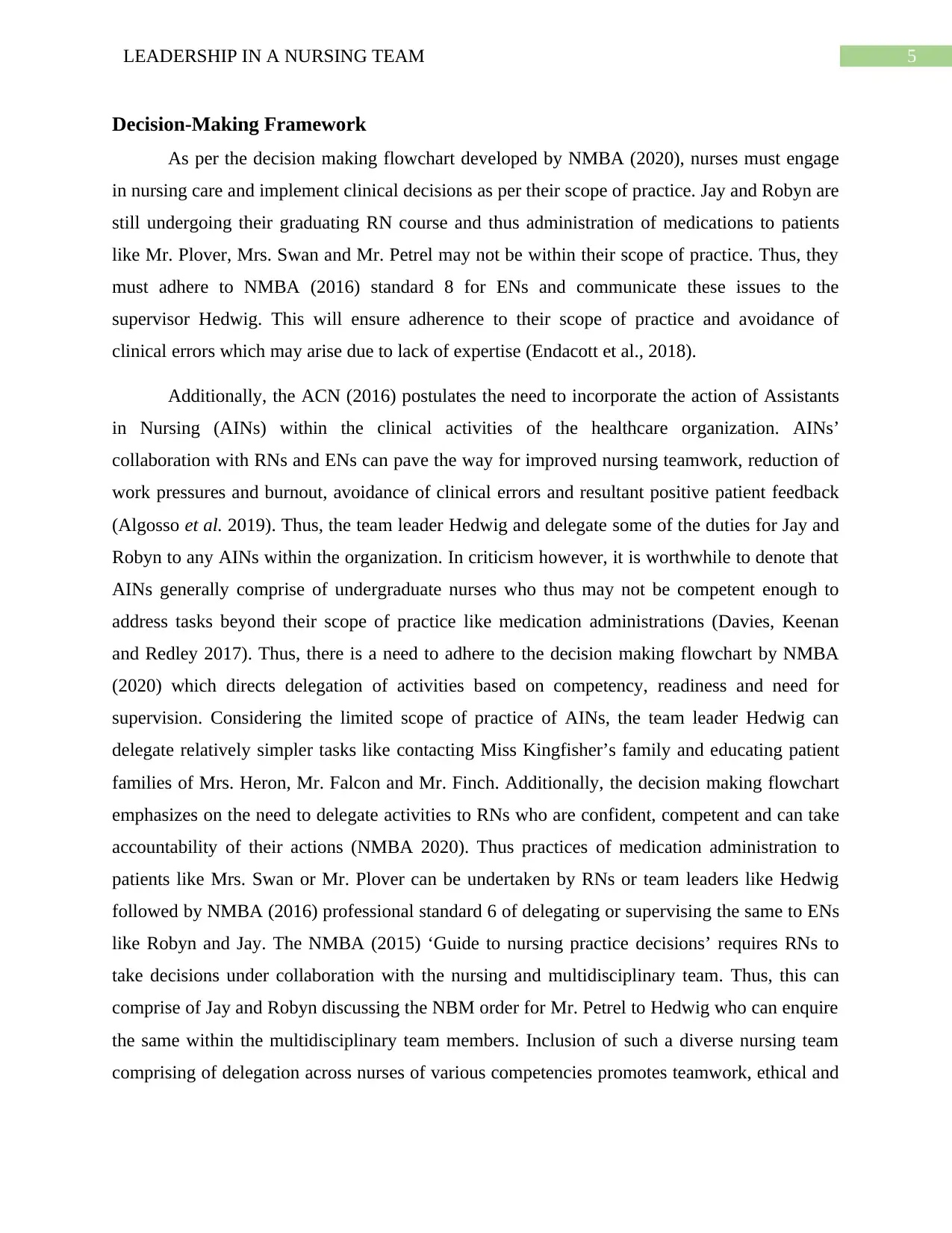
5LEADERSHIP IN A NURSING TEAM
Decision-Making Framework
As per the decision making flowchart developed by NMBA (2020), nurses must engage
in nursing care and implement clinical decisions as per their scope of practice. Jay and Robyn are
still undergoing their graduating RN course and thus administration of medications to patients
like Mr. Plover, Mrs. Swan and Mr. Petrel may not be within their scope of practice. Thus, they
must adhere to NMBA (2016) standard 8 for ENs and communicate these issues to the
supervisor Hedwig. This will ensure adherence to their scope of practice and avoidance of
clinical errors which may arise due to lack of expertise (Endacott et al., 2018).
Additionally, the ACN (2016) postulates the need to incorporate the action of Assistants
in Nursing (AINs) within the clinical activities of the healthcare organization. AINs’
collaboration with RNs and ENs can pave the way for improved nursing teamwork, reduction of
work pressures and burnout, avoidance of clinical errors and resultant positive patient feedback
(Algosso et al. 2019). Thus, the team leader Hedwig and delegate some of the duties for Jay and
Robyn to any AINs within the organization. In criticism however, it is worthwhile to denote that
AINs generally comprise of undergraduate nurses who thus may not be competent enough to
address tasks beyond their scope of practice like medication administrations (Davies, Keenan
and Redley 2017). Thus, there is a need to adhere to the decision making flowchart by NMBA
(2020) which directs delegation of activities based on competency, readiness and need for
supervision. Considering the limited scope of practice of AINs, the team leader Hedwig can
delegate relatively simpler tasks like contacting Miss Kingfisher’s family and educating patient
families of Mrs. Heron, Mr. Falcon and Mr. Finch. Additionally, the decision making flowchart
emphasizes on the need to delegate activities to RNs who are confident, competent and can take
accountability of their actions (NMBA 2020). Thus practices of medication administration to
patients like Mrs. Swan or Mr. Plover can be undertaken by RNs or team leaders like Hedwig
followed by NMBA (2016) professional standard 6 of delegating or supervising the same to ENs
like Robyn and Jay. The NMBA (2015) ‘Guide to nursing practice decisions’ requires RNs to
take decisions under collaboration with the nursing and multidisciplinary team. Thus, this can
comprise of Jay and Robyn discussing the NBM order for Mr. Petrel to Hedwig who can enquire
the same within the multidisciplinary team members. Inclusion of such a diverse nursing team
comprising of delegation across nurses of various competencies promotes teamwork, ethical and
Decision-Making Framework
As per the decision making flowchart developed by NMBA (2020), nurses must engage
in nursing care and implement clinical decisions as per their scope of practice. Jay and Robyn are
still undergoing their graduating RN course and thus administration of medications to patients
like Mr. Plover, Mrs. Swan and Mr. Petrel may not be within their scope of practice. Thus, they
must adhere to NMBA (2016) standard 8 for ENs and communicate these issues to the
supervisor Hedwig. This will ensure adherence to their scope of practice and avoidance of
clinical errors which may arise due to lack of expertise (Endacott et al., 2018).
Additionally, the ACN (2016) postulates the need to incorporate the action of Assistants
in Nursing (AINs) within the clinical activities of the healthcare organization. AINs’
collaboration with RNs and ENs can pave the way for improved nursing teamwork, reduction of
work pressures and burnout, avoidance of clinical errors and resultant positive patient feedback
(Algosso et al. 2019). Thus, the team leader Hedwig and delegate some of the duties for Jay and
Robyn to any AINs within the organization. In criticism however, it is worthwhile to denote that
AINs generally comprise of undergraduate nurses who thus may not be competent enough to
address tasks beyond their scope of practice like medication administrations (Davies, Keenan
and Redley 2017). Thus, there is a need to adhere to the decision making flowchart by NMBA
(2020) which directs delegation of activities based on competency, readiness and need for
supervision. Considering the limited scope of practice of AINs, the team leader Hedwig can
delegate relatively simpler tasks like contacting Miss Kingfisher’s family and educating patient
families of Mrs. Heron, Mr. Falcon and Mr. Finch. Additionally, the decision making flowchart
emphasizes on the need to delegate activities to RNs who are confident, competent and can take
accountability of their actions (NMBA 2020). Thus practices of medication administration to
patients like Mrs. Swan or Mr. Plover can be undertaken by RNs or team leaders like Hedwig
followed by NMBA (2016) professional standard 6 of delegating or supervising the same to ENs
like Robyn and Jay. The NMBA (2015) ‘Guide to nursing practice decisions’ requires RNs to
take decisions under collaboration with the nursing and multidisciplinary team. Thus, this can
comprise of Jay and Robyn discussing the NBM order for Mr. Petrel to Hedwig who can enquire
the same within the multidisciplinary team members. Inclusion of such a diverse nursing team
comprising of delegation across nurses of various competencies promotes teamwork, ethical and
⊘ This is a preview!⊘
Do you want full access?
Subscribe today to unlock all pages.

Trusted by 1+ million students worldwide
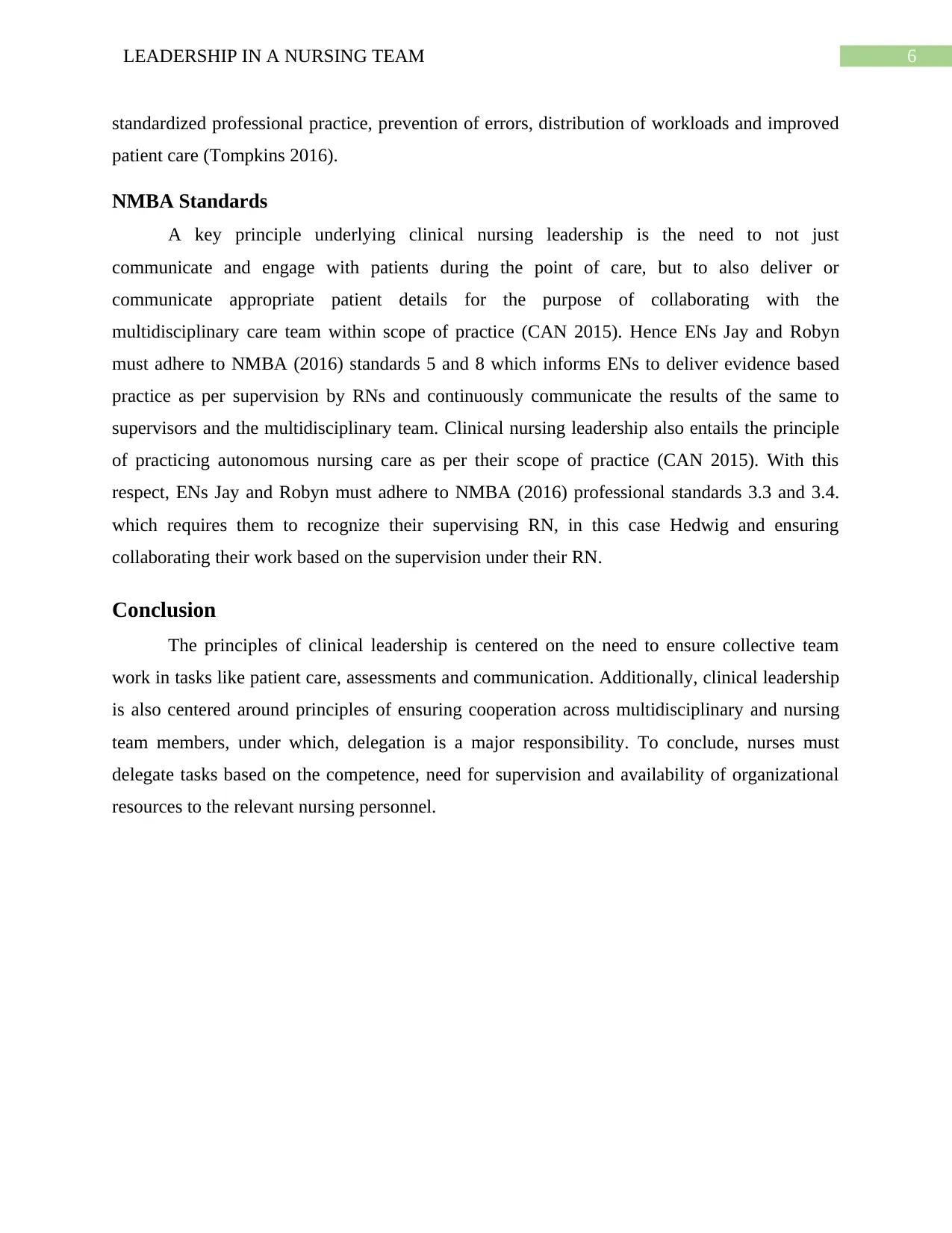
6LEADERSHIP IN A NURSING TEAM
standardized professional practice, prevention of errors, distribution of workloads and improved
patient care (Tompkins 2016).
NMBA Standards
A key principle underlying clinical nursing leadership is the need to not just
communicate and engage with patients during the point of care, but to also deliver or
communicate appropriate patient details for the purpose of collaborating with the
multidisciplinary care team within scope of practice (CAN 2015). Hence ENs Jay and Robyn
must adhere to NMBA (2016) standards 5 and 8 which informs ENs to deliver evidence based
practice as per supervision by RNs and continuously communicate the results of the same to
supervisors and the multidisciplinary team. Clinical nursing leadership also entails the principle
of practicing autonomous nursing care as per their scope of practice (CAN 2015). With this
respect, ENs Jay and Robyn must adhere to NMBA (2016) professional standards 3.3 and 3.4.
which requires them to recognize their supervising RN, in this case Hedwig and ensuring
collaborating their work based on the supervision under their RN.
Conclusion
The principles of clinical leadership is centered on the need to ensure collective team
work in tasks like patient care, assessments and communication. Additionally, clinical leadership
is also centered around principles of ensuring cooperation across multidisciplinary and nursing
team members, under which, delegation is a major responsibility. To conclude, nurses must
delegate tasks based on the competence, need for supervision and availability of organizational
resources to the relevant nursing personnel.
standardized professional practice, prevention of errors, distribution of workloads and improved
patient care (Tompkins 2016).
NMBA Standards
A key principle underlying clinical nursing leadership is the need to not just
communicate and engage with patients during the point of care, but to also deliver or
communicate appropriate patient details for the purpose of collaborating with the
multidisciplinary care team within scope of practice (CAN 2015). Hence ENs Jay and Robyn
must adhere to NMBA (2016) standards 5 and 8 which informs ENs to deliver evidence based
practice as per supervision by RNs and continuously communicate the results of the same to
supervisors and the multidisciplinary team. Clinical nursing leadership also entails the principle
of practicing autonomous nursing care as per their scope of practice (CAN 2015). With this
respect, ENs Jay and Robyn must adhere to NMBA (2016) professional standards 3.3 and 3.4.
which requires them to recognize their supervising RN, in this case Hedwig and ensuring
collaborating their work based on the supervision under their RN.
Conclusion
The principles of clinical leadership is centered on the need to ensure collective team
work in tasks like patient care, assessments and communication. Additionally, clinical leadership
is also centered around principles of ensuring cooperation across multidisciplinary and nursing
team members, under which, delegation is a major responsibility. To conclude, nurses must
delegate tasks based on the competence, need for supervision and availability of organizational
resources to the relevant nursing personnel.
Paraphrase This Document
Need a fresh take? Get an instant paraphrase of this document with our AI Paraphraser
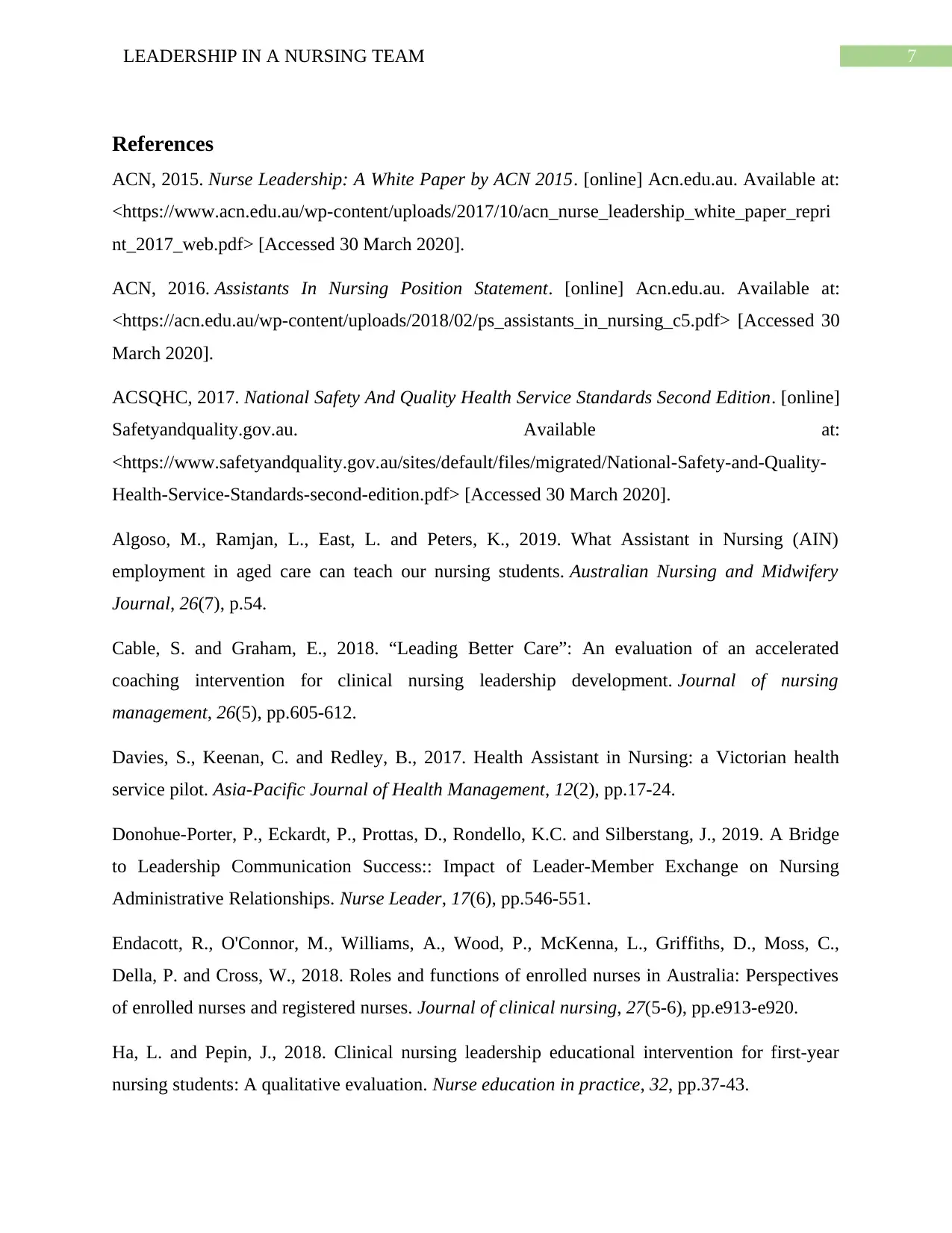
7LEADERSHIP IN A NURSING TEAM
References
ACN, 2015. Nurse Leadership: A White Paper by ACN 2015. [online] Acn.edu.au. Available at:
<https://www.acn.edu.au/wp-content/uploads/2017/10/acn_nurse_leadership_white_paper_repri
nt_2017_web.pdf> [Accessed 30 March 2020].
ACN, 2016. Assistants In Nursing Position Statement. [online] Acn.edu.au. Available at:
<https://acn.edu.au/wp-content/uploads/2018/02/ps_assistants_in_nursing_c5.pdf> [Accessed 30
March 2020].
ACSQHC, 2017. National Safety And Quality Health Service Standards Second Edition. [online]
Safetyandquality.gov.au. Available at:
<https://www.safetyandquality.gov.au/sites/default/files/migrated/National-Safety-and-Quality-
Health-Service-Standards-second-edition.pdf> [Accessed 30 March 2020].
Algoso, M., Ramjan, L., East, L. and Peters, K., 2019. What Assistant in Nursing (AIN)
employment in aged care can teach our nursing students. Australian Nursing and Midwifery
Journal, 26(7), p.54.
Cable, S. and Graham, E., 2018. “Leading Better Care”: An evaluation of an accelerated
coaching intervention for clinical nursing leadership development. Journal of nursing
management, 26(5), pp.605-612.
Davies, S., Keenan, C. and Redley, B., 2017. Health Assistant in Nursing: a Victorian health
service pilot. Asia-Pacific Journal of Health Management, 12(2), pp.17-24.
Donohue-Porter, P., Eckardt, P., Prottas, D., Rondello, K.C. and Silberstang, J., 2019. A Bridge
to Leadership Communication Success:: Impact of Leader-Member Exchange on Nursing
Administrative Relationships. Nurse Leader, 17(6), pp.546-551.
Endacott, R., O'Connor, M., Williams, A., Wood, P., McKenna, L., Griffiths, D., Moss, C.,
Della, P. and Cross, W., 2018. Roles and functions of enrolled nurses in Australia: Perspectives
of enrolled nurses and registered nurses. Journal of clinical nursing, 27(5-6), pp.e913-e920.
Ha, L. and Pepin, J., 2018. Clinical nursing leadership educational intervention for first-year
nursing students: A qualitative evaluation. Nurse education in practice, 32, pp.37-43.
References
ACN, 2015. Nurse Leadership: A White Paper by ACN 2015. [online] Acn.edu.au. Available at:
<https://www.acn.edu.au/wp-content/uploads/2017/10/acn_nurse_leadership_white_paper_repri
nt_2017_web.pdf> [Accessed 30 March 2020].
ACN, 2016. Assistants In Nursing Position Statement. [online] Acn.edu.au. Available at:
<https://acn.edu.au/wp-content/uploads/2018/02/ps_assistants_in_nursing_c5.pdf> [Accessed 30
March 2020].
ACSQHC, 2017. National Safety And Quality Health Service Standards Second Edition. [online]
Safetyandquality.gov.au. Available at:
<https://www.safetyandquality.gov.au/sites/default/files/migrated/National-Safety-and-Quality-
Health-Service-Standards-second-edition.pdf> [Accessed 30 March 2020].
Algoso, M., Ramjan, L., East, L. and Peters, K., 2019. What Assistant in Nursing (AIN)
employment in aged care can teach our nursing students. Australian Nursing and Midwifery
Journal, 26(7), p.54.
Cable, S. and Graham, E., 2018. “Leading Better Care”: An evaluation of an accelerated
coaching intervention for clinical nursing leadership development. Journal of nursing
management, 26(5), pp.605-612.
Davies, S., Keenan, C. and Redley, B., 2017. Health Assistant in Nursing: a Victorian health
service pilot. Asia-Pacific Journal of Health Management, 12(2), pp.17-24.
Donohue-Porter, P., Eckardt, P., Prottas, D., Rondello, K.C. and Silberstang, J., 2019. A Bridge
to Leadership Communication Success:: Impact of Leader-Member Exchange on Nursing
Administrative Relationships. Nurse Leader, 17(6), pp.546-551.
Endacott, R., O'Connor, M., Williams, A., Wood, P., McKenna, L., Griffiths, D., Moss, C.,
Della, P. and Cross, W., 2018. Roles and functions of enrolled nurses in Australia: Perspectives
of enrolled nurses and registered nurses. Journal of clinical nursing, 27(5-6), pp.e913-e920.
Ha, L. and Pepin, J., 2018. Clinical nursing leadership educational intervention for first-year
nursing students: A qualitative evaluation. Nurse education in practice, 32, pp.37-43.
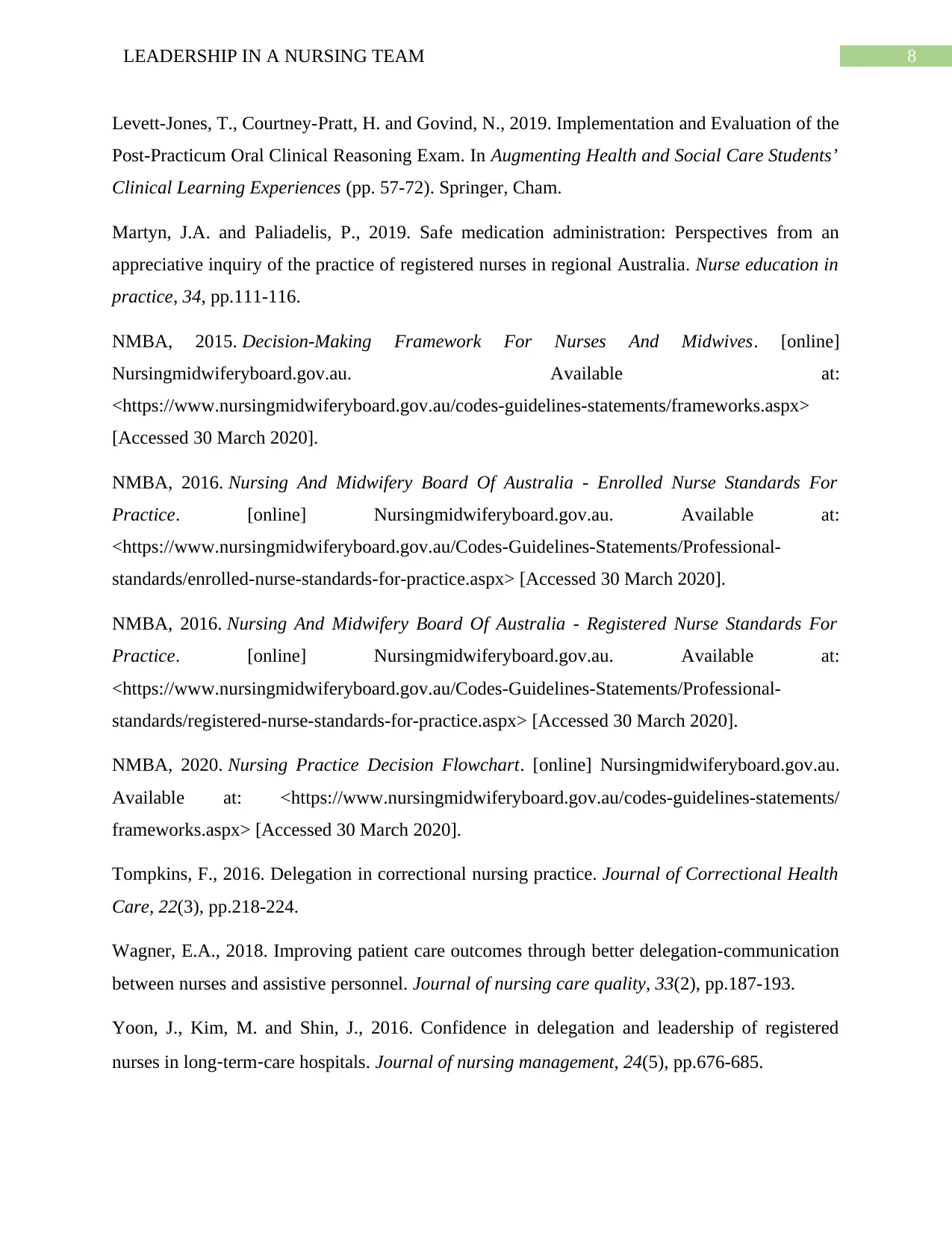
8LEADERSHIP IN A NURSING TEAM
Levett-Jones, T., Courtney-Pratt, H. and Govind, N., 2019. Implementation and Evaluation of the
Post-Practicum Oral Clinical Reasoning Exam. In Augmenting Health and Social Care Students’
Clinical Learning Experiences (pp. 57-72). Springer, Cham.
Martyn, J.A. and Paliadelis, P., 2019. Safe medication administration: Perspectives from an
appreciative inquiry of the practice of registered nurses in regional Australia. Nurse education in
practice, 34, pp.111-116.
NMBA, 2015. Decision-Making Framework For Nurses And Midwives. [online]
Nursingmidwiferyboard.gov.au. Available at:
<https://www.nursingmidwiferyboard.gov.au/codes-guidelines-statements/frameworks.aspx>
[Accessed 30 March 2020].
NMBA, 2016. Nursing And Midwifery Board Of Australia - Enrolled Nurse Standards For
Practice. [online] Nursingmidwiferyboard.gov.au. Available at:
<https://www.nursingmidwiferyboard.gov.au/Codes-Guidelines-Statements/Professional-
standards/enrolled-nurse-standards-for-practice.aspx> [Accessed 30 March 2020].
NMBA, 2016. Nursing And Midwifery Board Of Australia - Registered Nurse Standards For
Practice. [online] Nursingmidwiferyboard.gov.au. Available at:
<https://www.nursingmidwiferyboard.gov.au/Codes-Guidelines-Statements/Professional-
standards/registered-nurse-standards-for-practice.aspx> [Accessed 30 March 2020].
NMBA, 2020. Nursing Practice Decision Flowchart. [online] Nursingmidwiferyboard.gov.au.
Available at: <https://www.nursingmidwiferyboard.gov.au/codes-guidelines-statements/
frameworks.aspx> [Accessed 30 March 2020].
Tompkins, F., 2016. Delegation in correctional nursing practice. Journal of Correctional Health
Care, 22(3), pp.218-224.
Wagner, E.A., 2018. Improving patient care outcomes through better delegation-communication
between nurses and assistive personnel. Journal of nursing care quality, 33(2), pp.187-193.
Yoon, J., Kim, M. and Shin, J., 2016. Confidence in delegation and leadership of registered
nurses in long‐term‐care hospitals. Journal of nursing management, 24(5), pp.676-685.
Levett-Jones, T., Courtney-Pratt, H. and Govind, N., 2019. Implementation and Evaluation of the
Post-Practicum Oral Clinical Reasoning Exam. In Augmenting Health and Social Care Students’
Clinical Learning Experiences (pp. 57-72). Springer, Cham.
Martyn, J.A. and Paliadelis, P., 2019. Safe medication administration: Perspectives from an
appreciative inquiry of the practice of registered nurses in regional Australia. Nurse education in
practice, 34, pp.111-116.
NMBA, 2015. Decision-Making Framework For Nurses And Midwives. [online]
Nursingmidwiferyboard.gov.au. Available at:
<https://www.nursingmidwiferyboard.gov.au/codes-guidelines-statements/frameworks.aspx>
[Accessed 30 March 2020].
NMBA, 2016. Nursing And Midwifery Board Of Australia - Enrolled Nurse Standards For
Practice. [online] Nursingmidwiferyboard.gov.au. Available at:
<https://www.nursingmidwiferyboard.gov.au/Codes-Guidelines-Statements/Professional-
standards/enrolled-nurse-standards-for-practice.aspx> [Accessed 30 March 2020].
NMBA, 2016. Nursing And Midwifery Board Of Australia - Registered Nurse Standards For
Practice. [online] Nursingmidwiferyboard.gov.au. Available at:
<https://www.nursingmidwiferyboard.gov.au/Codes-Guidelines-Statements/Professional-
standards/registered-nurse-standards-for-practice.aspx> [Accessed 30 March 2020].
NMBA, 2020. Nursing Practice Decision Flowchart. [online] Nursingmidwiferyboard.gov.au.
Available at: <https://www.nursingmidwiferyboard.gov.au/codes-guidelines-statements/
frameworks.aspx> [Accessed 30 March 2020].
Tompkins, F., 2016. Delegation in correctional nursing practice. Journal of Correctional Health
Care, 22(3), pp.218-224.
Wagner, E.A., 2018. Improving patient care outcomes through better delegation-communication
between nurses and assistive personnel. Journal of nursing care quality, 33(2), pp.187-193.
Yoon, J., Kim, M. and Shin, J., 2016. Confidence in delegation and leadership of registered
nurses in long‐term‐care hospitals. Journal of nursing management, 24(5), pp.676-685.
⊘ This is a preview!⊘
Do you want full access?
Subscribe today to unlock all pages.

Trusted by 1+ million students worldwide
1 out of 9
Your All-in-One AI-Powered Toolkit for Academic Success.
+13062052269
info@desklib.com
Available 24*7 on WhatsApp / Email
![[object Object]](/_next/static/media/star-bottom.7253800d.svg)
Unlock your academic potential
Copyright © 2020–2025 A2Z Services. All Rights Reserved. Developed and managed by ZUCOL.
